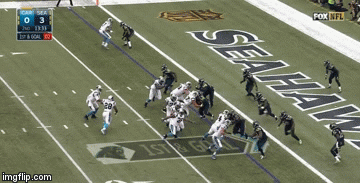How Cam Newton's Rushing Will Impact the NFC Championship

Cam Newton is a quarterback, a probable MVP one at that.
While the league has morphed toward a hyper-efficient passing game that’s in some cases made the game easier for quarterbacks, Newton, with a lack of credible pass catchers, was able to remain efficient in the passing game while also being the key piece in guiding the ground game for the Panthers.
During the regular season, Carolina had the second lowest pass-to-run ratio for any team in the league, topped by only the Buffalo Bills.
They were also one of the most efficient running teams in the NFL by our Net Expected Points (NEP) metric. NEP measures the value of each play on the field based on how an average team would be expected to score in each scenario using historical data. The Panthers ranked fifth in Adjusted Rushing NEP per play, led mostly by the effectiveness of Newton.
What does this mean for the matchup on Sunday?
Carrying the Load
Part of the success of the Carolina run game has to do with the complexity of the scheme. The Panthers run atypical formations for today’s game -- even employing a fullback puts them against the grain -- which leads to a high volume of run plays that can be run from counter to power to the zone read. Add in an offensive line that’s been much better at run blocking than expected and the Panthers become one of the toughest teams to stop on the ground.
Some of it was scrambling, but Newton also saw his share of designed runs, which led him to be the league’s best runner by Rushing NEP. Newton was worth 41.2 Rushing NEP, nearly double the total value of the top running back, Buffalo’s Karlos Williams at 24.9. But while Newton was the league's best runner, it wasn't from massive games. He only had one 100-yard rushing game, which came Week 15 against the New York Giants. Much of Newton's value on the ground was situation-based, converting first downs and touchdowns.
It might be surprising to some, though, that running back Jonathan Stewart was not one the league’s best rushers despite the overall team efficiency. Among 44 running backs who carried the ball at least 100 times this season, Stewart was just 22nd in Rushing NEP per attempt. Among even more high volume backs -- 15 had 200 or more carries -- Stewart’s Rushing NEP per attempt ranked ninth.
Add in an ankle injury that he sustained in the Divisional Round against the Seattle Seahawks and Stewart’s effectiveness has a bit of a question mark surrounding it entering the NFC Championship Game. Stewart has been a full participant in practice during the week and has been cleared to play on Sunday.
It won’t help that the Panthers are facing one of the best run defenses in the NFL from the regular season. The Arizona Cardinals ranked second in Adjusted NEP per play against the run, behind only the New York Jets, who were led by former Cardinals defensive coordinator Todd Bowles.
Scoring Chances
Where the Panthers really excelled running the ball this season was in short yardage and scoring situations, both led by their quarterback. With one or two yards to go for a first down, Newton had a Rushing Success Rate -- percentage of runs resulting in positive NEP -- of 78.6 percent, well above his overall Rushing Success Rate of 63 percent.
When those short yardage plays came on third or fourth down, Newton’s success rate jumped to 87.5 percent -- 14 successes on 16 attempts. His 0.34 Rushing NEP per attempt on those 19 carries blew away Stewart’s production in the same area -- 0.07 Rushing NEP per attempt on 21 carries.
Newton’s most dangerous area of the field, though, was inside the 10-yard line. Newton rushed 19 times inside the 10 and scored nine times. He had a Success Rate of 68.4 percent, which is impressive considering expected points on a given play are much higher that close to the end zone.
Looking at the types of plays the Panthers were able to run to get Newton toward the end zone, it’s not hard to see why they were so impressive in that distance. (Video courtesy NFL Game Pass.)

These types of plays are what makes Carolina so dangerous on the ground all over the field but especially in this area. Newton has the option to handoff to Stewart while the entire offensive line is blocking toward the side Newton will run on a keep. Stewart gets the ball if there’s no defender staying to the left and it’s an easy score. If Newton has to keep, like he does here, there’s already a barricade of linemen in front of him clearing the way to the end zone.
Arizona, however, spent the season as one of the league’s best run defenses around their own goal line. Only two teams gave up fewer rushing yards per play running inside the 10 than the Cardinals did at 0.84 yards.
Yes, this is a very limited part of the field, but the Panthers offense was able to get into this territory quite often during the regular season. Carolina ran 82 plays inside the opponent’s 10, which was the third highest in the league -- only Pittsburgh and Jacksonville ran more. No team ran more rushing plays in this area, though, as 50 of Carolina’s 82 plays within the 10 came on the ground.
With two of the most balanced teams in the league squaring off for a chance to head to Santa Clara -- both teams rank within the top-10 of Adjusted NEP per play in passing and rushing offense, and pass defense; Carolina ranks 11th for run defense -- a small advantage at this point of the field could prove to be the edge needed to move onto the Super Bowl.
















